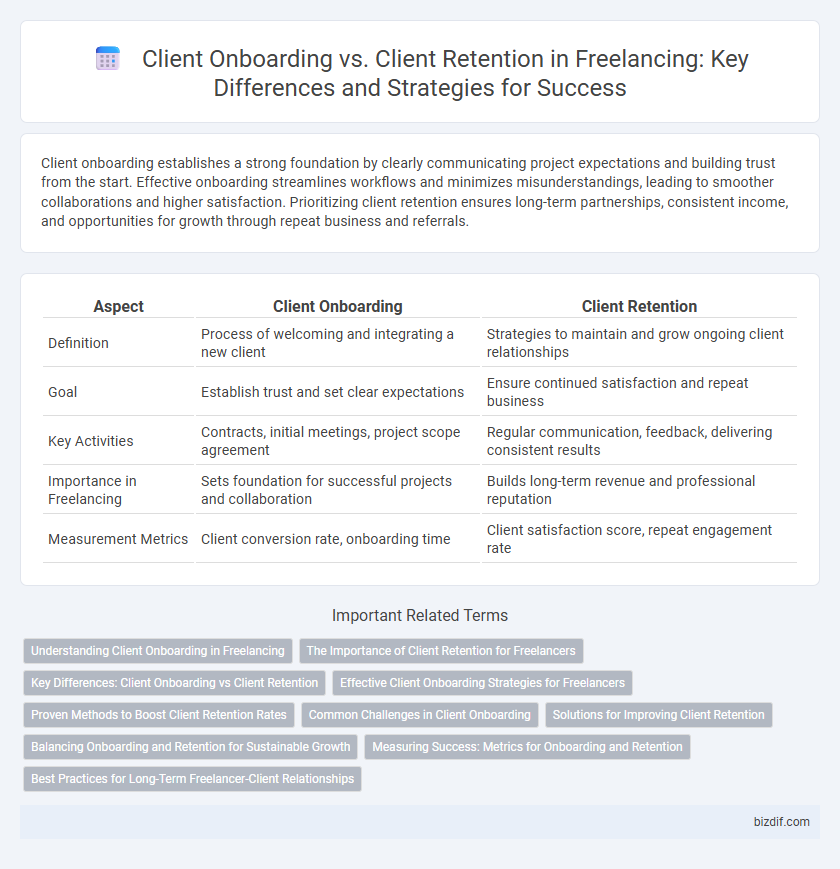Client onboarding establishes a strong foundation by clearly communicating project expectations and building trust from the start. Effective onboarding streamlines workflows and minimizes misunderstandings, leading to smoother collaborations and higher satisfaction. Prioritizing client retention ensures long-term partnerships, consistent income, and opportunities for growth through repeat business and referrals.
Table of Comparison
| Aspect | Client Onboarding | Client Retention |
|---|---|---|
| Definition | Process of welcoming and integrating a new client | Strategies to maintain and grow ongoing client relationships |
| Goal | Establish trust and set clear expectations | Ensure continued satisfaction and repeat business |
| Key Activities | Contracts, initial meetings, project scope agreement | Regular communication, feedback, delivering consistent results |
| Importance in Freelancing | Sets foundation for successful projects and collaboration | Builds long-term revenue and professional reputation |
| Measurement Metrics | Client conversion rate, onboarding time | Client satisfaction score, repeat engagement rate |
Understanding Client Onboarding in Freelancing
Understanding client onboarding in freelancing is crucial for establishing a strong foundation and setting clear expectations through transparent communication and detailed project briefs. Effective onboarding streamlines workflows, reduces misunderstandings, and builds trust, increasing the likelihood of repeat business. Prioritizing personalized onboarding experiences enhances client satisfaction and directly contributes to higher client retention rates.
The Importance of Client Retention for Freelancers
Client retention is crucial for freelancers as it ensures steady income and builds long-term professional relationships that lead to consistent project opportunities. Retained clients often result in higher lifetime value and reduced marketing costs compared to constantly acquiring new clients during onboarding. Prioritizing client retention fosters trust, enhances reputation, and encourages referrals, driving sustainable growth for freelance careers.
Key Differences: Client Onboarding vs Client Retention
Client onboarding involves guiding new clients through initial engagement processes, setting expectations, and establishing communication channels, whereas client retention focuses on continuous relationship management, delivering consistent value, and fostering long-term loyalty. Onboarding metrics emphasize time-to-value and satisfaction during the first interactions, while retention metrics track repeat business, customer lifetime value, and churn rates. Effective onboarding reduces early dropout risk, and strong retention strategies maximize recurring revenue and referral potential in freelancing.
Effective Client Onboarding Strategies for Freelancers
Effective client onboarding strategies for freelancers include clear communication of project scope, setting expectations upfront, and providing a streamlined process for contract signing and initial payments. Using tools like project management software and regular check-ins enhances transparency and builds trust from the beginning. These practices reduce misunderstandings and create a strong foundation for client retention.
Proven Methods to Boost Client Retention Rates
Implementing personalized communication and setting clear expectations during client onboarding significantly enhances trust and satisfaction, which are critical for client retention. Utilizing CRM tools to track client interactions and feedback allows freelancers to address concerns proactively, fostering long-term relationships. Consistent delivery of high-quality work and offering value-added services encourage repeat business and referrals, ultimately boosting client retention rates.
Common Challenges in Client Onboarding
Common challenges in client onboarding include unclear communication of project scope, inconsistent expectations between freelancer and client, and delays in gathering essential project information. Navigating these issues effectively is crucial to establishing trust and setting a strong foundation for client retention. Streamlining onboarding processes with clear documentation and timely follow-ups minimizes misunderstandings and improves long-term client satisfaction.
Solutions for Improving Client Retention
Effective client retention strategies include personalized communication, consistent delivery of high-quality work, and proactive problem-solving to anticipate client needs. Leveraging client feedback to tailor services and implementing loyalty programs can strengthen long-term relationships and increase repeat business. Utilizing CRM tools helps track client interactions and preferences, enabling freelancers to maintain engagement and foster trust over time.
Balancing Onboarding and Retention for Sustainable Growth
Balancing client onboarding and client retention is crucial for sustainable growth in freelancing, as onboarding new clients drives immediate revenue while retention ensures long-term profitability and steady cash flow. Efficient onboarding processes reduce client acquisition costs and set clear expectations, fostering strong initial relationships that improve client satisfaction. Prioritizing retention strategies, such as personalized communication and consistent value delivery, maximizes lifetime client value and builds a reliable client base essential for business stability.
Measuring Success: Metrics for Onboarding and Retention
Tracking client onboarding success involves monitoring metrics such as time to first project completion, client satisfaction scores, and initial communication responsiveness. Client retention metrics focus on repeat project frequency, client lifetime value (CLV), and churn rate over specific periods. Analyzing these data points provides a clear picture of overall freelancing business health and sustainable growth.
Best Practices for Long-Term Freelancer-Client Relationships
Effective client onboarding in freelancing ensures clear expectations, transparent communication, and timely project outlines, which establish a strong foundation for trust and professionalism. Implementing personalized follow-ups and regular progress updates enhances client retention by demonstrating commitment and adaptability to evolving needs. Prioritizing feedback loops and consistently delivering quality work fosters long-term freelancer-client relationships, maximizing mutual growth and project success.
Client onboarding vs Client retention Infographic

 bizdif.com
bizdif.com